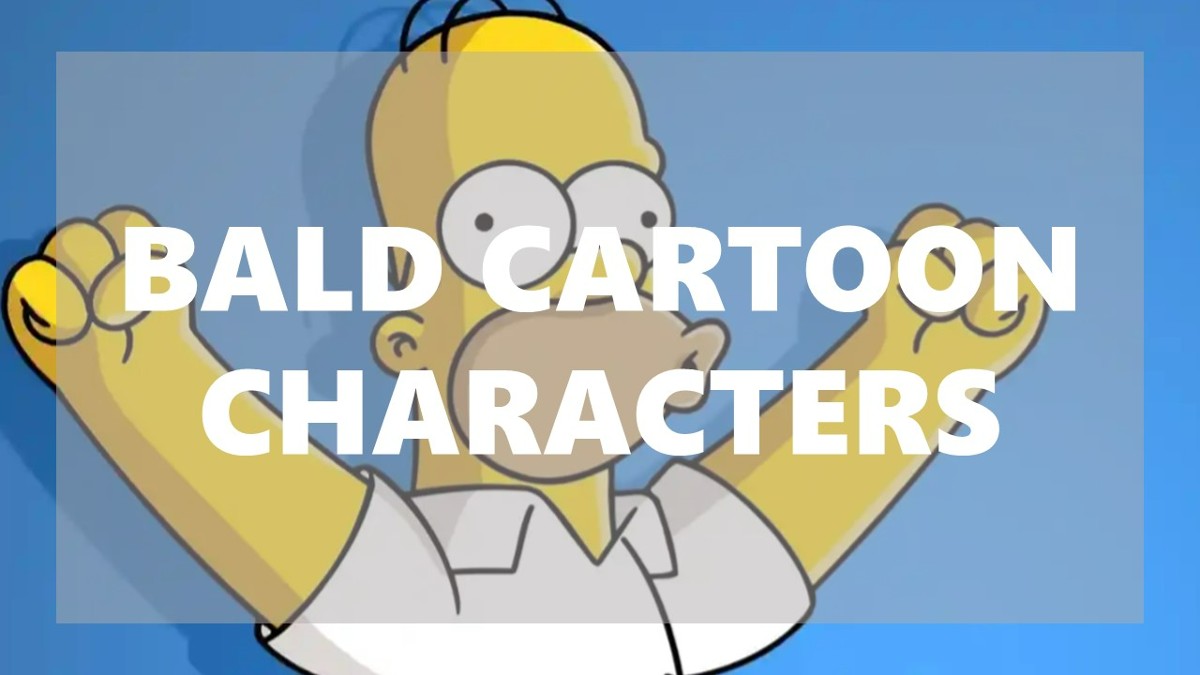Let’s talk about bald people cartoon characters because they’ve been stealing our hearts for decades without even trying. From the lovable Homer Simpson to the hilarious Mr. Bean, these hairless wonders have become an integral part of our pop culture. Whether you’re a fan of animated series or just appreciate good storytelling, bald cartoon characters bring something unique to the table. They’re not just characters; they’re icons that teach us valuable life lessons through their humor, struggles, and triumphs.
Now, you might be wondering why bald cartoon characters even matter. Well, buckle up because this is where it gets interesting. These characters often represent resilience, confidence, and the ability to embrace who you are, no matter how different you may seem. In a world obsessed with perfection, bald cartoon characters remind us that imperfections can make someone more relatable and endearing.
So, whether you’re here to reminisce about your favorite bald cartoon characters or to discover new ones, you’re in the right place. This article dives deep into the world of bald people cartoon, exploring their origins, cultural significance, and the lessons we can learn from them. Let’s get started!
Read also:Discover The Rich Culture And Entertainment At Yakama Nation Legends Casino
Table of Contents:
- Biography of Famous Bald Cartoon Characters
- The History of Bald People in Cartoons
- Why Are Bald Cartoon Characters So Popular?
- Life Lessons from Bald Cartoon Characters
- The Impact of Bald People Cartoon on Pop Culture
- How Are Bald Cartoon Characters Designed?
- The Role of Comedy in Bald Cartoon Characters
- Breaking Stereotypes: Beyond the Bald Joke
- The Future of Bald People Cartoon
- Conclusion: Celebrating Baldness in Animation
Biography of Famous Bald Cartoon Characters
Before we dive into the nitty-gritty, let’s take a moment to appreciate some of the most iconic bald cartoon characters. Here’s a quick rundown of who they are and what makes them special:
Meet the Legends
Homer Simpson is arguably one of the most famous bald cartoon characters out there. This lovable oaf from Springfield is the epitome of chaos and hilarity. He’s clumsy, lazy, and utterly unforgettable. Then there’s Mr. Bean, a British sensation who doesn’t need words to make you laugh. His bald head and quirky antics have entertained millions around the globe.
Data and Facts
| Name | Series | First Appearance | Creator |
|---|---|---|---|
| Homer Simpson | The Simpsons | 1989 | Matt Groening |
| Mr. Bean | Mr. Bean | 1990 | Rowan Atkinson & Richard Curtis |
| Bender | Futurama | 1999 | Matthew Groening |
The History of Bald People in Cartoons
Baldness in cartoons has a rich history that dates back to the early days of animation. Back in the day, animators used bald characters as a way to simplify designs and focus on expressions rather than intricate hairstyles. This trend continued over the years, evolving into something much more meaningful.
One of the earliest bald cartoon characters was Popeye’s nemesis, Bluto. He was a menacing figure with a bald head that symbolized his brute strength. As time went on, bald characters began to take on more complex roles, representing everything from wisdom to humor.
Why Bald Characters Stick Around
- Bald characters are easier to animate.
- They often serve as a visual shortcut for certain personality traits.
- Audiences find them memorable and relatable.
Why Are Bald Cartoon Characters So Popular?
The popularity of bald cartoon characters can be attributed to several factors. First and foremost, they’re incredibly versatile. A bald character can be funny, serious, heroic, or even villainous, depending on the story being told. Plus, their lack of hair makes them stand out in a crowd of animated characters.
Read also:Millie Bobby Brown Wedding Guests A Comprehensive Look At The Celebrities And Special Guests
Another reason for their popularity is the universal appeal of baldness. It transcends cultural and linguistic barriers, making these characters accessible to a global audience. Whether you’re in America, Europe, or Asia, a bald cartoon character is likely to resonate with you in some way.
Life Lessons from Bald Cartoon Characters
Beyond entertainment, bald cartoon characters offer valuable life lessons. Take Homer Simpson, for example. Despite his many flaws, he always finds a way to come out on top. This teaches us that it’s okay to make mistakes as long as you learn from them. Similarly, Mr. Bean shows us that laughter is the best medicine, even in the most challenging situations.
Key Takeaways
- Embrace your imperfections.
- Find humor in life’s challenges.
- Confidence is key to success.
The Impact of Bald People Cartoon on Pop Culture
Bald cartoon characters have left an indelible mark on pop culture. They’ve inspired countless memes, merchandise, and even real-life fashion trends. For instance, the iconic bald head of Homer Simpson has become a symbol of comedy and chaos. Meanwhile, Mr. Bean’s baldness has become synonymous with wit and intelligence.
These characters have also played a role in breaking down stereotypes about baldness. Instead of being seen as a negative trait, baldness is now celebrated for its uniqueness and charm. This shift in perception is a testament to the power of animation to change societal norms.
How Are Bald Cartoon Characters Designed?
Designing a bald cartoon character involves more than just removing the hair. Animators must consider how the character’s baldness affects their overall appearance and personality. For example, a shiny bald head might suggest confidence, while a rough texture could imply toughness.
Color choices also play a crucial role in character design. A pale complexion might emphasize vulnerability, while a darker tone could indicate strength. Ultimately, the design of a bald cartoon character should align with the story being told and the message being conveyed.
The Role of Comedy in Bald Cartoon Characters
Comedy is at the heart of many bald cartoon characters. From Homer Simpson’s bumbling antics to Bender’s sarcastic remarks, these characters have a knack for making us laugh. But comedy isn’t just about jokes; it’s about connecting with the audience on a deeper level.
Through humor, bald cartoon characters tackle serious issues like identity, self-esteem, and acceptance. They remind us that laughter is a powerful tool for healing and understanding. In a world filled with stress and uncertainty, these characters offer a much-needed escape.
Breaking Stereotypes: Beyond the Bald Joke
While bald cartoon characters have brought joy to millions, they’ve also been the subject of stereotypes. The bald villain trope, for instance, has been overused in animation. However, modern creators are working to break these stereotypes by portraying bald characters in a more nuanced light.
Shows like "Futurama" and "The Simpsons" have successfully challenged traditional notions of baldness by showcasing complex, multidimensional characters. This shift reflects a growing understanding of diversity and inclusion in animation.
The Future of Bald People Cartoon
As animation continues to evolve, the future looks bright for bald cartoon characters. With advancements in technology and a greater emphasis on diversity, we can expect to see even more diverse and inclusive representations of baldness in animation.
Moreover, the rise of streaming platforms has opened up new opportunities for independent creators to showcase their work. This means we might see even more unique and innovative bald cartoon characters in the years to come.
Conclusion: Celebrating Baldness in Animation
In conclusion, bald people cartoon characters have come a long way from being mere stereotypes to becoming beloved icons of pop culture. They teach us valuable lessons, challenge societal norms, and bring joy to millions of viewers around the world. Whether you’re a fan of Homer Simpson, Mr. Bean, or Bender, there’s no denying the charm and charisma of these hairless heroes.
So, the next time you watch a cartoon featuring a bald character, take a moment to appreciate the artistry and creativity behind their design. And don’t forget to share this article with your friends and family. Who knows? You might just inspire someone to embrace their baldness and celebrate their uniqueness.
References:
- “The Simpsons: A Cultural History,” by John Alberti
- “Rowan Atkinson: The Life and Career of Mr. Bean,” by David Batty
- “Futurama: The Complete Series,” DVD commentary


